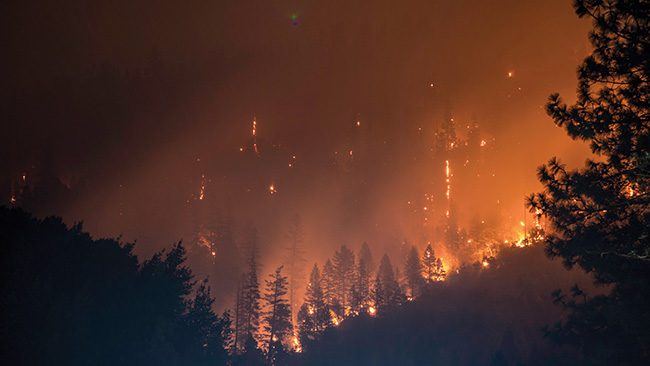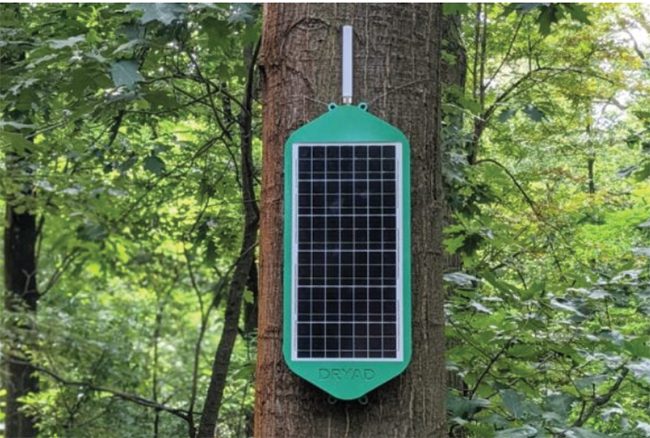Electric Utility Protocols Can Mitigate Impacts from Wildfires
As the frequency and intensity of wildfires continue to increase across the U.S., electric utilities face unprecedented challenges in maintaining a reliable power supply and keeping communities safe. In response, these utilities are developing new operational protocols and strategies to mitigate the impacts of wildfires on their infrastructure, and ultimately their customers.
There are many key initiatives that can be implemented by electric utilities to reduce the risk of wildfires caused by their equipment. Many of these also can help utilities restore power as quickly as possible after a wildfire event. From early detection and prevention techniques to enhanced emergency response and infrastructure resilience, utilities are implementing various initiatives to reduce the risk of damage from wildfires and ensure that power remains reliable and resilient.
Early Detection
Utility companies doubtless suffer greatly from wildfires (Figure 1) due to the disruptions to service that can result. But there’s another concern, one with great financial impact. That’s when the cause of a wildfire can be traced to a company’s infrastructure, when equipment such as power lines, transformers, or other factors controlled by the power company are determined to be at fault.
 |
|
1. Drought conditions in many parts of the world have contributed to massive wildfires that have caused billions of dollars in damage in recent years. Utility companies are investing in technologies designed to provide early detection of wildfires, and conditions that could lead to fires, in their service territories. Courtesy: Dryad Networks |
Six of the most-costly recent wildfires across the U.S. have been attributed to a utility’s equipment. Pacific Gas & Electric (PG&E) in California filed for bankruptcy due to wildfires in its service territory, with the utility eventually reaching a $13.5 billion settlement with victims. PG&E still faces some legal issues related to California fires.
By detecting and responding to wildfires early, utility companies can significantly reduce the risk of damage to their infrastructure and limit the impact on customers. In addition, early wildfire detection can help utilities identify potential hazards, and prioritize maintenance and repair work to reduce the risk of future fires.
Earlier detection, and steps toward prevention, are among the most important aspects of wildfire mitigation for electric utilities. Companies are increasingly using a mix of technologies to monitor weather conditions, and also to detect fires before they can spread.
For example, in 2018, San Diego Gas & Electric (SDG&E) deployed a network of weather stations and cameras to monitor fire risk in real-time, and provide early warning to its emergency response teams. The utility also uses drones to inspect power lines and detect potential fire hazards such as vegetation or equipment damage.
Safety Inspection Programs
As the risk of wildfires continues to increase across the U.S., many utility companies are implementing wildfire safety inspection programs. These programs involve thoroughly inspecting electrical equipment to help identify and mitigate risks associated with wildfires.
Wildfire safety inspection programs typically involve an in-depth assessment of electrical equipment and infrastructure by qualified personnel. The aim is to identify potential hazards that could lead to a wildfire and recommend solutions for reducing the risk. This may include replacing obsolete equipment, clearing debris from power lines, clearing trees and underbrush near transmission lines and towers, or installing fire barriers around vulnerable areas.
An example of a successful wildfire safety program is the California Public Utilities Commission’s Public Safety Power Shutoff initiative, or PSPS. The program, first developed in 2012, became more widely known after devastating wildfires in 2017 and 2018, including the 2018 Camp Fire, which destroyed more than 19,000 buildings and killed 85 people.
A PSPS is designed to reduce the risk of wildfires caused by faulty electric infrastructure. A utility can shut off power to customers when extreme weather conditions are present or expected, particularly in the case of high winds that could cause the rapid spread of a wildfire.
PG&E has developed a wildfire safety inspection program that identifies risks, and supports the inspection and repair of equipment that might cause a wildfire. The utility’s program includes inspecting more than 100,000 miles of power lines, clearing vegetation and debris, and conducting enhanced inspections during periods of high fire risk.
In 2022, the Electric Power Research Institute (EPRI) partnered with Incubatenergy Labs, a summit and demonstration program. The partnership is designed to connect business start-ups with utility companies, with the aim of advancement of electrification, decarbonization, and grid modernization. During their Incubatenergy Labs Demo Day in Minneapolis, Minnesota, in October of last year, fire detection was an important part of the agenda.
 |
|
2. This solar-powered sensor from Dryad Networks is considered an “ultra-early” wildfire detection technology. The California Department of Forestry and Fire Protection, known as CAL FIRE, is piloting the technology in a trial program in that state’s Jackson Demonstration State Forest. Courtesy: Dryad Networks |
Early detection and prevention techniques are critical components of electric utilities’ wildfire mitigation strategies. By investing in advanced monitoring and forecasting technologies (Figure 2), utilities can minimize the risk of damage to their infrastructure and reduce the impact of wildfires on their customers.
Vegetation Management
Electric utilities are also implementing a range of other initiatives to mitigate the impacts of wildfires on their operations and customers. In the wake of the record-breaking wildfire season in 2018, and again in 2021, utility companies started looking to vegetation management to mitigate costs and reduce the risk of future wildfires.
Vegetation management effectively controls the growth and spread of vegetation near power lines and other electrical equipment. Utility companies can significantly reduce the risk of fires caused by sparks or malfunctioning equipment by keeping potential fuel sources away from power lines. Utilities clear vegetation along power line corridors and use advanced technologies such as drones and LiDAR (light detection and ranging) to identify potential hazards. Some utilities are also investing in technologies such as insulated power lines and covered conductors that are less susceptible to damage from vegetation.
Louisville Gas & Electric and Kentucky Utilities have implemented a successful pilot project that leverages satellite imagery and artificial intelligence to detect vegetation infringements, diseased or decaying trees, and nearby threats. This innovative approach to vegetation management helps prevent wildfires and ensures that the utility infrastructure remains safe and reliable for customers. Meanwhile, Southern California Edison (SCE) launched its own program in 2019 aimed at reducing the risk of wildfire in areas with high fire danger by removing trees near power lines, and increasing their routine inspections and maintenance efforts on transmission towers and substations.
State and Local Government Support
Another key initiative is enhanced emergency response and restoration capabilities. Electric utilities are working closely with state and local emergency response agencies to ensure they are well-prepared to respond to wildfires and other natural disasters. Power restoration and emergency response capabilities must be at the forefront of communication between utility companies and emergency services to ensure that people remain safe during emergencies.
Many states have created mutual aid agreements between utility companies, and state and local emergency services to work together more effectively during an outage or disaster. These agreements are designed to help ensure seamless communication between utilities and emergency service groups, which is essential during times of crisis when rapid response is needed. The agreements also allow each party to borrow resources from the other, if necessary, during an emergency, helping both sides better prepare for any eventuality.
Agreements may include pre-staging equipment and personnel in high-risk areas, and conducting regular training exercises. In addition, utilities are investing in advanced technologies such as mobile command centers and communication systems that can be deployed quickly to support emergency response efforts.
Future-Proofing Infrastructure
Electric utilities are also taking steps to improve their resilience to wildfires and other natural disasters. This includes investing in more robust infrastructure, such as underground power lines, and microgrids operating independently during a power outage. In addition, many are exploring new technologies such as energy storage and renewable energy that can provide backup power during emergencies and reduce the reliance on traditional fossil-fuel-based power plants.
One of the most expensive but effective solutions for improving infrastructure is burying power lines so they are not exposed to potential fire risks. This is especially true in dry climates where vegetation can easily catch fire, putting power lines at risk. Utility companies such as SDG&E and SCE have invested heavily in this solution, spending more than $1 billion on undergrounding projects since 2017.
Another tactic being employed by utility companies is energy storage technology, particularly batteries and pumped hydroelectric energy storage (PHES) systems. These technologies enable utility companies to store electricity when demand is low, and then release it into the grid during peak times, or when additional power is needed due to an emergency or natural disaster. Companies like PG&E are using PHES technology as part of their energy mix; they have invested more than $2 billion in six new battery projects across the state of California since 2019.
Electric utility companies are increasingly developing new and innovative approaches to help safeguard against future disasters, building an adaptive strategy that leverages the latest technologies while also relying on the experience of seasoned professionals. The goal is to mitigate the impact of wildfires as much as possible and ensure that localities are adequately protected.
This is good news for citizens who live in wildfire-prone areas, and it also indicates increased cooperation among local governments, energy providers, and community members. By integrating the best resources available and dedicating meaningful effort toward better protection, electricity system operators are putting service at the forefront of operations, a decision that will surely benefit all involved in the long run.
—Ben Jones is marketing manager at Dryad Networks. Dryad provides ultra-early detection of wildfires, and health and growth monitoring of forests using solar-powered gas sensors in a large-scale internet of things sensor network.